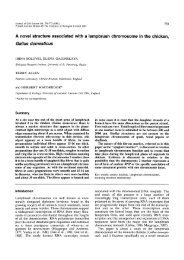European guidelines for youth AIDS peer education - University of ...
European guidelines for youth AIDS peer education - University of ...
European guidelines for youth AIDS peer education - University of ...
- No tags were found...
Create successful ePaper yourself
Turn your PDF publications into a flip-book with our unique Google optimized e-Paper software.
What <strong>European</strong> policy says about the matterIn Decision No. 647/96/EC <strong>of</strong> the <strong>European</strong> Parliament and the Council, <strong>AIDS</strong> is considered a ‘major scourge’and the decision provides that it is important to ‘promote the utilisation and proper use <strong>of</strong> condoms as ameans <strong>of</strong> preventing the HIV virus and other STD’ 2 . The decision further states that ‘the provision <strong>of</strong> in<strong>for</strong>mationto children and young people must begin at an early age in the general context <strong>of</strong> in<strong>for</strong>mation on hygiene andsexuality and health <strong>education</strong>.’ These decisions are not an ‘ideal’ but reflect the reality that a majority <strong>of</strong><strong>European</strong> young people have already experienced sexual intercourse by the age <strong>of</strong> 17.The global viewThe United Nations became involved in the issue in 1989, when the General Assembly adopted theConvention on the Rights <strong>of</strong> the Child (CRC). This document is perhaps more idealistic, but is specific tochildren and young people and deals directly with their participation in the issues that affect them in the<strong>for</strong>m <strong>of</strong> ‘rights’. Article 12 <strong>of</strong> the CRC gives children the right to express their opinion and to have thatopinion taken into account in issues that affect them. Article 13 gives children the right to obtain and makeknown in<strong>for</strong>mation as well as to express their opinions, except when this violates the right <strong>of</strong> others.Articles 14 through 17 give children the freedom <strong>of</strong> thought and religion (Art. 14), the freedom <strong>of</strong>association (Art. 15), the right to privacy (Art.16), and the right <strong>of</strong> access to appropriate in<strong>for</strong>mation (Art. 17).Culture change and tokenismThe documents and agreements mentioned above reveal that we are in the challenging process <strong>of</strong>transferring the control <strong>of</strong> health promotion and <strong>education</strong> to local communities and their citizens,including young people. Adults will need to let go <strong>of</strong> some <strong>of</strong> the direct control they have over young peopleand endeavour to involve them in policy-making and prevention programmes. The end product <strong>of</strong>participation is not revolution or revolt, but a partnership between different age groups. This is a new role <strong>for</strong>young people and they will need to be guided into this new responsibility by adults.However, we must be careful to avoid the dangers <strong>of</strong> what Hart has called ‘manipulation’ and ‘tokenism’,where young people become mere ornaments in a political process 3 . The aim <strong>of</strong> participation is not simplyto give young people a voice, but to enable them to take responsibility <strong>for</strong> their own health. Peer <strong>education</strong>focuses directly on increasing <strong>youth</strong> participation and empowerment; to accomplish this task young p e o p l eneed support and guidance from adults.We need to seriously consider the benefits <strong>of</strong> young people participating in health promotion programmesand in the decisions that affect them. This is important because young people are an essential asset tosociety – making a commitment to them is a commitment to the future 4 .<strong>European</strong> <strong>guidelines</strong> <strong>for</strong> <strong>youth</strong> <strong>AIDS</strong> <strong>peer</strong> <strong>education</strong> 15
















